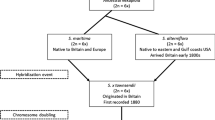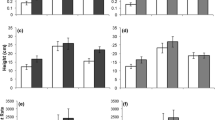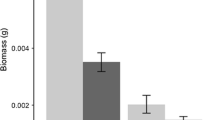Abstract
Non-native plant species invasions can have significant ecological and economic impacts. Finding patterns that predict and explain the success of non-native species has thus been an important focus in invasion ecology. The evolution of increased competitive ability (EICA) hypothesis has been a frequently used framework to understand invasion success. Evolution of increased competitive ability predicts that (1) non-native populations will escape from coevolved specialist herbivores that were present within the native range and this release from specialist herbivores should result in relaxed selection pressure on specialist-related defense traits, (2) there will be a trade-off between allocation of resources for resistance against specialist herbivores and allocation to traits related to competitive ability, and (3) this shift will allow more allocation to competitive ability traits. We tested the predictions of EICA in the model plant Mimulus guttatus, a native of western North America (WNA). We compared how well the predictions of EICA fit patterns in two non-native regions, the United Kingdom (UK), an older more successful invasion, and eastern North America (ENA), a younger less successful invasion. We completed extensive herbivore surveys and grew plants derived from multiple populations in each region in a common greenhouse environment to test adherence to the predictions of EICA. We found evidence of specialist herbivore escape in the UK, but not the ENA plants. Compared to native plants the UK plants had lower levels of resistance traits, were taller, and produced larger and more flowers, while the ENA plants had mostly equivalent traits to the WNA plants. Plants from the UK conformed to the predictions of EICA more closely than those from ENA. The UK invasion is an older, more successful invasion, suggesting that support for EICA predictions may be highest in more successful invasions.








Similar content being viewed by others
References
Awmack CS, Leather SR (2002) Host plant quality and fecundity in herbivorous insects. Annu Rev Entomol 47:817–844
Benrey B, Denno RF (1997) The slow-growth–high-mortality hypothesis: a test using the cabbage butterfly. Ecology 78:987–999
Blossey B, Notzold R (1995) Evolution of increased competitive ability in invasive nonindigenous plants: a hypothesis. J Ecol 83:887–889
Blumenthal DM (2006) Interactions between resource availability and enemy release in plant invasion. Ecol Lett 9 (7):887–895
Bossdorf O, Auge H, Lafuma L, Rogers WE, Siemann E, Prati D (2005) Phenotypic and genetic differentiation between native and introduced plant populations. Oecologia 144:1–11
Burke MJ, Grime JP (1996) An experimental study of plant community invasibility. Ecol 77(3):776–790
Callaway RM, Maron JL (2006) What have exotic plant invasions taught us over the past 20 years? Trends Ecol Evol 21:369–374
Callaway RM, Ridenour WM (2004) Novel weapons: invasive success and the evolution of increased competitive ability. Front Ecol Environ 2(8):436–443
Callaway RM, Vivanco JM (2006) Can plant biochemistry contribute to understanding of invasion ecology? Trends Plant Sci 11:574–580
Carpenter D, Cappuccino N (2005) Herbivory, time since introduction and the invasiveness of exotic plants. J Ecol 93(2):315–321
Carr DE, Dudash MR (1995) Inbreeding depression under a competitive regime in Mimulus guttatus: consequences for potential male and female function. Heredity 75:437–443
Carrillo J, McDermott D, Siemann E (2014) Loss of specificity: native but not invasive populations of Triadica sebifera vary in tolerance to different herbivores. Oecologia 174:863–871
Catford JA, Jansson R, Nilsson C (2009) Reducing redundancy in invasion ecology by integrating hypotheses into a single theoretical framework. Divers Distrib 15:22–40
Coley PD, Bryant JP, Chapin FS (1985) Resource availability and plant antiherbivore defense. Science 230:895–899
Cox GW (2004) Alien species and evolution: the evolutionary ecology of exotic plants, animals, microbes, and interacting native species. Island Press, Washington
Cripps MG, Hinz HL, McKenney JL, Price WJ, Schwarzländer M (2009) No evidence for an ‘evolution of increased competitive ability for the invasive Lepidium draba. Basic Appl Ecol 10:103–112
Crooks JA, Soulé ME, Sandlund OT (1999) Lag times in population explosions of invasive species: causes and implications. In Invasive species and biodiversity management, Kluwer, Boston
Davis MA, Thompson K (2001) Invasion terminology: should ecologists define their terms differently than others? No, not if we want to be of any help! Bull-Ecol Soc Am 82(3):206–206
Dehnen-Schmutz K, Touza J, Perrings C, Williamson M (2007) A century of the ornamental plant trade and its impact on invasion success. Divers Distrib 13:527–534
Diez JM, Sullivan JJ, Hulme PE, Edwards G, Duncan RP (2008) Darwin’s naturalization conundrum: dissecting taxonomic patterns of species invasions. Ecol Lett 11:674–681
Feeny P (1976) Plant apparency and chemical defense. In: Wallace J (ed) Biochemical interaction between plants and insects. Springer, Boston, pp 1–40
Felker-Quinn E, Schweitzer JA, Bailey JK (2013) Meta-analysis reveals evolution in invasive plant species but little support for evolution of increased competitive ability (EICA). Ecol Evol 3:739–751
Gleason HA, Cronquist A (1991) Manual of vascular plants of northeastern United States and adjacent Canada. Van Nostrand, New York
Gurevitch J, Fox GA, Wardle GM, Taub D (2011) Emergent insights from the synthesis of conceptual frameworks for biological invasions. Ecol Lett 14:407–418
Haukioja E, Neuvonen S (1985) Induced long-term resistance of birch foliage against defoliators: defensive or incidental? Ecology 66:1303–1308
Hierro JL, Maron JL, Callaway RM (2005) A biogeographical approach to plant invasions: the importance of studying exotics in their introduced and native range. J Ecol 93:5–15
Holeski LM (2007) Within and between generation phenotypic plasticity in trichome density of Mimulus guttatus. J Evol Biol 20:2092–2100
Holeski LM, Keefover-Ring K, Bowers MD, Harnenz ZT, Lindroth RL (2013) Patterns of phytochemical variation in Mimulus guttatus (yellow monkeyflower). Chem Ecol 39:525–536
Huang W, Siemann E, Wheeler GS, Zou J, Carrillo J, Ding J (2010) Resource allocation to defence and growth are driven by different responses to generalist and specialist herbivory in an invasive plant. J Ecol 98:1157–1167
Keane RM, Crawley MJ (2002) Exotic plant invasions and the enemy release hypothesis. Trends Ecol Evol 17:164–170
Kearns CA, Inouye DW (1993) Techniques for pollination biologists. University press of Colorado
Keefover-Ring K, Holeski LM, Bowers MD, Clauss AD, Lindroth RL (2014) Phenylpropanoid glycosides of Mimulus guttatus (yellow monkeyflower). Phytochem Lett 10:132–139
Kooyers NJ, Blackman BK, Holeski LM (2017) Optimal defense theory explains deviations from latitudinal herbivory defense hypothesis. Ecology 98:1036–1048
Lau JA, Schultheis EH (2015) When two invasion hypotheses are better than one. New Phytol 205:958–960
Liu H, Stiling P, Pemberton RW (2007) Does enemy release matter for invasive plants? Evidence from a comparison of insect herbivore damage among invasive, non-invasive and native congeners. Biol Invasions 9:773–781
Mack RN, Simberloff D, Lonsdale MW, Evans H, Clout M, Bazzaz FA (2000) Biotic invasions: causes, epidemiology, global consequences, and control. Ecol Appl 10:689–710
Maron JL, Vilà M (2001) When do herbivores affect plant invasion? Evidence for the natural enemies and biotic resistance hypothesis. Oikos 95:361–373
Martin NH (2004) Flower size preferences of the honeybee (Apis mellifera) foraging on Mimulus guttatus (Scrophulariaceae). Evol Ecol Res 6:777–782
Martinez KA (2018) Comparative ecophysiology of native and invasive plants across populations, species, and continents. Doctoral dissertation, Syracuse University
McCune B, Mefford MJ (2011) PC-ORD: multivariate analysis of ecological data. MjM Software Design
Minchin PR, (2018) Non-metric multidimensional scaling of community data: myths and misconceptions. Paper presented at the Ecological Society of America, 103rd Annual meeting, New Orleans, LA, 5th–8th Aug
Murren CJ, Chang CC, Dudash MR (2009) Patterns of selection of two North American native and nonnative populations of monkeyflower (Phrymaceae). New Phytol 183:691–701
Orians CM, Ward D (2010) Evolution of plant defenses in nonindigenous environments. Annu Rev Entomol 55:439–459
Parker JD, Hay ME (2005) Biotic resistance to plant invasions? Native herbivores prefer non-native plants. Ecol Lett 8:959–967
Preston CD, Pearman DA, Dines TD (2002) New atlas of the British and Irish Flora. Oxford University Press, Oxford
Puzey J, Vallejo-Marín M (2014) Genomics of invasion: diversity and selection in introduced populations of monkeyflowers (M imulus guttatus). Mol Ecol 23(18):4472–4485
R Core Team (2013) R: a language and environment for statistical computing. R Foundation for Statistical Computing, Vienna, Austria. https://www.R-project.org/
Rapo C, Müller-Schärer H, Vrieling K, Schaffner U (2010) Is there rapid evolutionary response in introduced populations of tansy ragwort, Jacobaea vulgaris, when exposed to biological control? Evol Ecol 24(5):1081–1099
Reichard SH, White P (2001) Horticulture as a pathway of invasive plant introductions in the United States: most invasive plants have been introduced for horticultural use by nurseries, botanical gardens, and individuals. Bioscience 51:103–113
Rotter MC, Holeski LM (2017) The lepidopteran herbivores of the model plant. J Lepid Soc 71(3):162–168
Rotter MC, Holeski LM (2018) A meta-analysis of the evolution of increased competitive ability hypothesis: genetic-based trait variation and herbivory resistance trade-offs. Biol Invasions 20:2647–2660
Rotter MC, Couture JJ, Rothwell EM, Garcia J, Holeski LM (2018) Evolutionary ecology of plant resistance traits across the herbivore diet spectrum: a test in the model plant Mimulus guttatus. Evol Ecol Res 19:423–440
Rueden CT, Schindelin J, Hiner MC, DeZonia BE, Walter AE, Arena ET, Eliceiri KW (2017) Image J2: ImageJ for the next generation of scientific image data. BMC Bioinform 18:529
Siemann E, Rogers WE (2003) Increased competitive ability of an invasive tree may be limited by an invasive beetle. Ecol Appl 13:1503–1507
Tokarska-Guzik B, Dajdok Z (2010) NOBANIS. Invasive Alien Species Fact Sheet: Mimulus guttatus. Online Database of the North European and Baltic Network on Invasive Alien Species, NOBANIS. www.nobanis.org
Truscott AM, Palmer SC, Soulsby C, Westaway S, Hulme PE (2008) Consequences of invasion by the alien plant Mimulus guttatus on the species composition and soil properties of riparian plant communities in Scotland. Perspect Plant Ecol Syst 10:231–240
Truscott AM, Soulsby C, Palmer SCF, Newell L, Hulme PE (2006) The dispersal characteristics of the invasive plant Mimulus guttatus and the ecological significance of increased occurrence of high-flow events. J Ecol 94:1080–1091
Twyford AD, Friedman J (2015) Adaptive divergence in the monkey flower is maintained by a chromosomal inversion. Evol 69(6):1476–1486
Vallejo-Marin M, Lye GC (2013) Hybridisation and genetic diversity in introduced Mimulus (Phrymaceae). Heredity 110:111–122
Valverde PL, Arroyo J, Núñez-Farfán J, Castillo G, Calahorra A, Pérez-Barrales R, Tapia-López R (2015) Natural selection on plant resistance to herbivores in the native and introduced range. AoB Plants 7:230–240
van Kleunen M, Fischer M (2008) Adaptive rather than non-adaptive evolution of Mimulus guttatus in its invasive range. Basic Appl Ecol 9:213–223
Vila M, Maron JL, Marco L (2005) Evidence for the enemy release hypothesis in Hypericum perforatum. Oecologia 142:474–479
Whitney KD, Gabler CA (2008) Rapid evolution in introduced species,‘invasive traits’ and recipient communities: challenges for predicting invasive potential. Div Dist 14:569–580
Wu CA, Lowry DB, Cooley AM, Wright KM, Lee YW, Willis JH (2008) Mimulus is an emerging model system for the integration of ecological and genomic studies. Heredity 100:220–230
Yuan YW (2018) Monkeyflowers (Mimulus): new model for plant developmental genetics and evo-devo. New Phytol 222:694–700
Acknowledgements
We thank the members of the Holeski lab group for assistance on various parts of this project. Phil Patterson helped with plant cultivation in the greenhouse. Thanks to Dean Robinson who let us study the plants on his property. Comments from Dr. Tom Whitham and Dr. Richard Hofstetter improved this manuscript.
Funding
Funding was provided by the NAU genes to environment fellowship program and the NAU Department of Biological Sciences. A special thanks to funding from the Michigan Botanical Foundation, Idaho Native Plant Society, and the Utah Native Plant Society.
Author information
Authors and Affiliations
Corresponding author
Ethics declarations
Conflict of interest
The authors declare no conflicts of interests.
Additional information
Publisher's Note
Springer Nature remains neutral with regard to jurisdictional claims in published maps and institutional affiliations.
Electronic supplementary material
Below is the link to the electronic supplementary material.
Rights and permissions
About this article
Cite this article
Rotter, M.C., Vallejo-Marin, M. & Holeski, L.M. A test of the evolution of increased competitive ability in two invaded regions. Evol Ecol 33, 713–735 (2019). https://doi.org/10.1007/s10682-019-10004-5
Received:
Revised:
Accepted:
Published:
Issue Date:
DOI: https://doi.org/10.1007/s10682-019-10004-5




